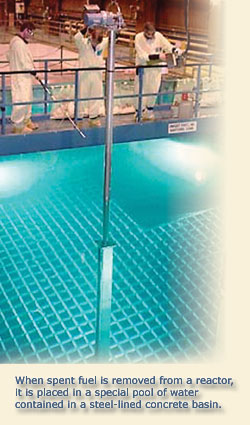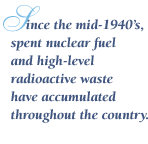 |
 |

What are spent nuclear fuel and high-level radioactive waste?
Spent nuclear fuel and high-level radioactive waste are materials from nuclear power plants and government defense programs. These materials contain highly radioactive elements, such as cesium, strontium, technetium, and neptunium. Some of these elements will remain radioactive for a few years, while others will be radioactive for millions of years. Scientists worldwide agree that the safest way to manage these materials is to dispose of them deep underground in what is called a geologic repository. Nuclear fuel: Fresh and spentTo make electricity, nuclear reactors use fuel made of solid ceramic pellets of enriched uranium that are sealed in strong metal tubes. The tubes are bundled together to form a nuclear fuel assembly. The uranium pellets are about the size of the tip of your little finger. Although small, the pellets release a tremendous amount of energy when used in a nuclear reactor. For example, one pellet has an amount of energy equivalent to almost one ton of coal. The energy released by the nuclear fuel produces great heat, which boils water into steam. The steam turns giant turbines, which generate the electricity. About 20 percent of the nation’s electricity is generated by nuclear power. After three or four years in a reactor, however, the uranium pellets are no longer efficient for producing electricity and the assembly is removed from the reactor. After removal, the entire assembly (now called spent nuclear fuel) is highly radioactive. All nuclear reactors produce spent fuel. Currently, there are reactors at commercial power plants, at government research facilities, and on about 40 percent of the U.S. Navy’s submarines and ships. If we were to take all the spent fuel produced to date in the United States and stack it side-by-side, end-to-end, the fuel assemblies would cover an area about the size of a football field to a depth of about five yards. Current methods for storing spent nuclear fuelWhen spent fuel is first removed from a reactor, it is placed in a special pool of water contained in a steel-lined concrete basin. The water cools the spent fuel and protects workers and the public from radiation. After it has cooled considerably, some commercial power plants and government facilities move the fuel to dry-storage containers made of steel and/or concrete to shield radiation. The containers are either placed upright on concrete pads, or stored horizontally in metal canisters in concrete bunkers. High-level radioactive wasteWith the end of the Cold War, the United States has been working to close and clean up obsolete weapons plants and dispose of nuclear weapons materials. This has created a need to dispose of highly radioactive material associated with weapons production. This material is called high-level radioactive waste. Until the late 1970s, the United States acquired materials for nuclear weapons by reprocessing spent nuclear fuel from government-owned nuclear reactors. Reprocessing is a method of chemically treating spent fuel to separate out uranium and plutonium. The byproduct of reprocessing is a highly radioactive sludge-like residue. The Department of Energy will not ship such residue to a repository until it is solidified and sealed in stainless steel canisters. * All high-level nuclear waste is currently stored at government facilities. A long-term environmental problemNuclear waste must be properly managed to minimize risk to the environment and to the health and safety of future generations. Since the mid-1940s, spent nuclear fuel and high-level radioactive waste have accumulated throughout the country. Currently, they are stored in temporary facilities at some 121 sites in 39 states. These storage sites are located in a mixture of urban, suburban, and rural environments — most are located near large bodies of water. In the United States today, over 161 million people reside within 75 miles of temporarily stored nuclear waste. Current storage methods shield any harmful radiation and are presently safe. However, modern aboveground storage structures are designed for temporary storage only, and will not withstand rain, wind, and other environmental factors for the tens of thousands of years during which the waste will be hazardous. Permanent disposal optionsFor decades, experts throughout the world have studied many options for permanently disposing of nuclear waste — including:
After analyzing these options, most scientists agree that disposal in an underground repository is the best long-term solution for safely managing highly radioactive wastes. This opinion is reflected in a 1990 report from the National Research Council of the National Academy of Sciences, which states that there is “a worldwide scientific consensus that deep geological disposal, the approach being followed by the United States, is the best option for disposing of highly radioactive waste.” In 2001, the National Research Council again reaffirmed that conclusion: “Geologic disposal remains the only scientifically and technically credible long-term solution available to meet the need for safety without reliance on active management.” ** As long as nuclear waste remains in a solid form and is properly shielded, it will not harm people or contaminate the environment — and over time it produces less and less radiation. The idea behind deep geologic disposal, therefore, is to keep the waste as dry and isolated as possible, for as long as possible, so that its radiation can diminish to safe levels. Isolated in a deep underground repository, the waste would not be subject to the many environmental factors that on the earth’s surface would cause it to break down into radioactive particles that could be dispersed by air or water into the accessible environment.
* In the U.S., all nuclear waste must be in solid form before it can be shipped to a repository. ** Board on Radioactive Waste Management, Rethinking High-Level Radioactive Waste Disposal, National Academy Press: Washington, D.C., 1990, p. vii. And: Disposition of High-Level Waste and Spent Nuclear Fuel: Continuing Societal and Technical Challenges, National Academy Press: Washington, D.C., 2001, p. 3.
|
|||
Yucca Mountain Project

